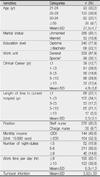Abstract
Purpose
The purpose of this study was to investigate the impact of the unit-level nurse practice environment on nurse turnover intention in the small and medium sized hospitals.
Methods
A cross-sectional study was conducted using a questionnaire survey with 308 nurses in 38 nursing units of 6 small and medium sized hospitals, having over 200 beds and under 300 beds and located in B metropolitan city. Data were collected from July 20 to August 10, 2011. Data were analyzed using hierarchical multiple regression.
Results
The mean turnover intention in nurses of small and medium sized hospitals was 3.52±0.53. Factors affecting turnover intention in the nurses included age, work unit, monthly income, number of night-duties, work hours per day and unit-level nurse practice environment. The unit-level nurse practice environment accounted for 15% of turnover intention when other variables were controlled.
Conclusion
The results of the study indicate that nurse turnover intention is associated with the nurse practice environment at the unit level. Small and medium sized hospitals can improve nurse retention and lower turnover intention by changing the nurse practice environment of unit, such as creating better support services and nurse participation in hospital affairs.
Figures and Tables
Table 3
Turnover Intention by General Characteristics of Nurses, Nurse Practice Environment, and Characteristics of Hospitals (N=308)

Table 4
Predictors of Nurses' Turnover Intention (N=308)

*Dummy variables: Marital status (single=1, married=0); Education level (diploma=1, bachelor=0); Work unit (general=1, special=0); Position (staff=1, charge=0); Monthly income (<200=1, ≥200=0); Number of night-duties (≥6=0, <5=1); Work time per day (≥10=0, ≤9=1); Nurse practice environment (mixed, poor=1, better=0); Hospital type (hospital=1, general hospital=0); Ownership (private=1, medical cooperation=0); Number of beds (<260=1, ≥260=0); Nurse staffing grade (3, 4 grade=0, 5, 6 grade=1).
References
1. Aiken LH, Clarke SP, Sloane DM, Lake ET, Cheney T. Effects of hospital care environment on patient mortality and nurse outcome. J Nurs Adm. 2008. 38:223–229. http://dx.doi.org/10.1097/01.NNA.0000312773.42352.d7.
2. Aiken LH, Havens DM, Sloane DM. The magnet nursing services recognition program: A comparison of two groups of magnet hospital. Am J Nurs. 2000. 100(3):26–35.
3. Baernholdt M, Mark B. The nurse work environment, job satisfaction and turnover rates in rural and urban nursing units. J Nurs Manag. 2009. 17:994–1001. http://dx.doi.org/10.1111/j.1365-2834.2009.01027.x.
4. Cho E, Choi M, Kim EY, Yoo IY, Lee NJ. Construct validity and reliability of the Korean version of the Practice Environment Scale of Nursing Work Index for Korean nurses. J Korean Acad Nurs. 2011. 41:325–332. http://dx.doi.org/10.4040/jkan.2011.41.3.325.
5. Choi EH, Kim JH, Lee HS, Jang EH, Kim BS. The effect of the intramural marketing activities on nurses' job satisfaction and turnover intention. J Korean Clin Nurs Res. 2009. 15:29–41.
6. Cimiotti JP, Quinlan PM, Larson EL, Pastor DK, Lin SX, Stone PW. The magnet process and the perceived work environment of nurses. Nurs Res. 2005. 54:384–390.
7. Er KS, Hur HK, Kim KK, Cho YJ, Kim EH, Kim SJ. The relationship between job characteristics, job satisfaction, and intents to leave among hospital nurses. J Korean Clin Nurs Res. 2004. 9(2):81–92.
8. Hardy S, Leiba-O'Sulivan S. The power behind empowerment: Implication for research and practice. Hum Relat. 1998. 51:451–483. http://dx.doi.org/10.1177/001872679805100402.
9. Hospital Nurses Association. Survey on hospital nurse staffing. 2010. Seoul: Author.
10. Jeong BJ, Kim HS, Hwang SK, Park JH, Song SK, Jeong MY, et al. A study on the according to the nursing shortage of job satisfaction and turnover intention of nurses. Korean J Health Serv Manag. 2011. 5(1):15–29.
11. Jeong JH, Kim JS, Kim KH. The risk factors influencing turnover intention of nurses. J Korean Acad Nurs Adm. 2008. 14(1):35–44.
12. Kang GN. Nurses' practice environment, nursing professionalism, career commitment, and turnover intention in the small-medium sized hospital. 2010. Seoul, Korea: Ewha Womans University;Unpublished master's thesis.
13. Kang SY, Um YR, Han SS. A professional nursing practice environment and its impact on nurses' task motivation. J Korean Acad Nurs. 2005. 35:353–361.
14. Kim JK. Job satisfaction and patient satisfaction related to nurse staffing. J Korean Acad Nurs Adm. 2007. 13:98–108.
15. Kim JK, Park SA. A study of the job satisfaction of clinical nurses related to nurse staffing. J Korean Acad Nurs Adm. 2003. 9:529–539.
16. Kim MA, Park KO, You SJ, Kim MJ, Kim ES. A survey of nursing activities in small and medium-size hospitals: Reasons for turnover. J Korean Clin Nurs Res. 2009. 15:149–165.
17. Kim MR. Influential factors on turnover intention of nurses: The affect of nurse's organizational commitment and career commitment to turnover intention. J Korean Acad Nurs Adm. 2007. 13:335–344.
18. Ko HJ. Nurse work environments, job satisfaction and intention to leave among nurses. 2010. Seoul, Korea: Hanyang University;Unpublished master's thesis.
19. Lake ET. Development of the practice environment scale of the nursing work index. Res Nurs Health. 2002. 25:176–188. http://dx.doi.org/10.1002/nur.10032.
20. Lake ET, Friese CR. Variations in nursing practice environments relation to staffing and hospital characteristics. Nurs Res. 2006. 55:1–9.
21. Lee HY. Effects of professional work environments on hospital. 2011. Seoul, Korea: Hanyang University;Unpublished master's thesis.
22. Lee YJ, Kim KB. Experiences of nurse turnover. J Korean Acad Nurs. 2008. 38:248–257.
23. Lee YT, Kim JD, Lee YH, Kang DU, Park JE. Nursing staff supply and survey by differential nursing medical fee. 2008. Seoul: Association of Small and Medium Hospitals.
24. McCusker J, Dendukuri N, Cardinal L, Laplante J, Bambonye L. Nursing work environment and quality of care: Differences between units at the same hospital. Int J Health Care Qual Assur Inc Leadersh Health Serv. 2004. 17:313–322. http://dx.doi.org/10.1108/09526860410557561.
25. Mobley WH. Employee Turnover: Cause, Consequences and Control. 1982. Massachusetts: Addision-Wesley.
26. Park YO, Lee KJ, Cho EH, Park HJ. Factors affecting turnover intention of nurses in long-term care facilities for elderly people. J Korean Gerontol Nurs. 2009. 11:81–89.
27. Yoo SJ, Choi YH. Predictive factors influencing turnover intention of nurses in small and medium-sized hospitals in Daegu city. J Korean Acad Nurs Adm. 2009. 15(1):16–25.
28. Van Bogaert P, Clarke S, Roelant E, Meulemans H, Heyning PV. Impacts of unit-level nurse practice environment and burnout on nurse-reported outcomes: A multilevel modelling approach. J Korean Clin Nurs Res. 2010. 19:1664–1674. http://dx.doi.org/10.1016/j.ijnurstu.2012.05.006.




 PDF
PDF ePub
ePub Citation
Citation Print
Print




 XML Download
XML Download